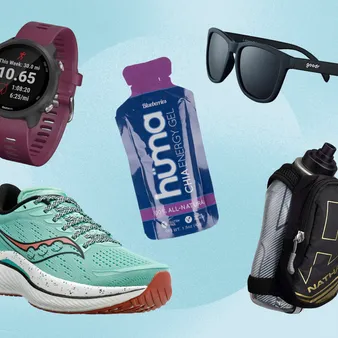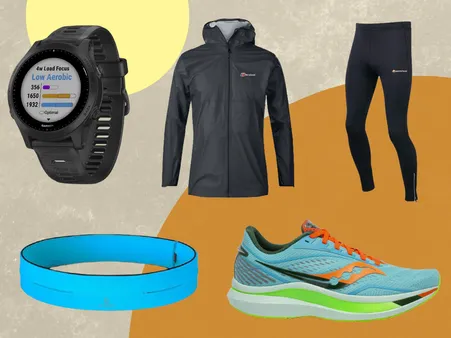Table of Contents
Welcome to Kizworld, your ultimate resource for all things running. Whether you're a seasoned marathoner or just starting out on your fitness journey, we've got you covered. In this comprehensive guide, we'll delve into The best running equipment and gear to help you achieve your running goals and elevate your performance to new heights. From shoes and apparel to gadgets and accessories, we'll provide insights and recommendations to ensure you have the right tools for the job. So lace up your shoes, get ready to hit the pavement, and let kizworld be your guide to the world of running.
The Best Running Equipment and Gear for Optimal Performance
I. Running Shoes: The Foundation of a Great Run
The Importance of Proper Footwear
Running shoes are an essential piece of gear for any runner, whether you're a beginner or a seasoned athlete. The right pair of shoes can make all the difference in your running experience, providing support, cushioning, and traction to help you perform your best. But with so many different running shoes on the market, it can be tough to know which ones are right for you. Here are a few things to keep in mind when choosing running shoes:
- Your foot type.
- Your running style.
- The surfaces you'll be running on.
- Your budget.
Choosing the Right Running Shoes
Once you've considered these factors, you can start narrowing down your choices. Here are some additional tips for choosing the right running shoes:
- Go to a specialty running store to get fitted for shoes. A qualified salesperson can help you find the right size and width, and recommend shoes that are appropriate for your foot type and running style.
- Try on several different pairs of shoes before you make a decision. Make sure the shoes fit snugly but not too tightly, and that they provide good support and cushioning.
- Take the shoes for a short run before you buy them. This will give you a chance to make sure they're comfortable and that they don't cause any pain or discomfort.
Caring for Your Running Shoes
Once you've found the right pair of running shoes, it's important to take care of them so they last. Here are a few tips for caring for your running shoes:
- Keep your shoes clean. Wipe them down with a damp cloth after each run, and be sure to dry them thoroughly before storing them.
- Don't put your shoes in the dryer. The heat can damage the materials in the shoes and shorten their lifespan.
- Store your shoes in a cool, dry place. Avoid storing them in direct sunlight or in extreme heat or cold.
- Replace your shoes every 300 to 500 miles. This will help to prevent injuries and ensure that you're getting the best performance from your shoes.
Related Posts
- The Best Running Shoes and Socks
- How to Choose the Right Running Shoes
- How to Care for Your Running Shoes
II. Apparel for All Conditions: Staying Comfortable While You Run
Apparel for All Conditions: Staying Comfortable While You Run
No matter the weather, you can find clothing designed to keep you dry and comfortable during your runs. In the summer, look for moisture-wicking fabrics that will help you stay cool and dry. In the winter, you'll want to layer up with warm clothing to keep the chill at bay.
Here are some items to keep in mind when choosing running apparel for different weather conditions:
- Summer: Look for lightweight, breathable fabrics that will wick away sweat.
- Winter: Layer up with warm clothing, starting with a base layer of moisture-wicking fabric. Add a mid-layer for insulation, and a waterproof outer layer to protect you from the elements.
- Rain: Choose a waterproof jacket and pants to keep you dry in wet weather.
- Wind: Wear a windbreaker or running jacket to block the wind and keep you warm.
- Snow: Invest in a good pair of snowshoes or cross-country skis if you plan on running in the snow.
Pro tip: When choosing running apparel, be sure to consider the type of activity you'll be doing. If you're going for a leisurely jog, you may not need as much clothing as you would for a long run or a race.
Weather Condition | Clothing |
Summer (warm) | Moisture-wicking t-shirt or tank top, shorts or running skirt, sports bra (for women), hat, sunglasses |
Winter (cold) | Base layer of moisture-wicking fabric, mid-layer for insulation, waterproof outer layer, hat, gloves, scarf |
Rain | Waterproof jacket and pants, hat, gloves |
Wind | Windbreaker or running jacket, hat, gloves |
Snow | Winter running jacket and pants, snowshoes or cross-country skis, hat, gloves, scarf |
Quote: "The best way to find the right running apparel is to experiment and see what works best for you. There's no one-size-fits-all solution, so take some time to try different things and find what makes you feel most comfortable and confident while you're running."
Top Running Competitions and Events How to Start Running for Beginners The Health Benefits of Running
Layering Up in Colder Weather
When running in colder weather, it's important to layer up your clothing so that you can adjust to changing temperatures. A good rule of thumb is to wear three layers:
- Base layer: This layer should be made of a moisture-wicking fabric to help keep you dry.
- Mid-layer: This layer provides insulation to keep you warm. Fleece or wool are good choices for this layer.
- Outer layer: This layer should be waterproof and windproof to protect you from the elements.
You may also want to consider wearing a hat, gloves, and scarf to keep your head, hands, and neck warm.
Staying Hydrated in Hot Weather
It's important to stay hydrated when running in hot weather, even if you don't feel thirsty. Drink plenty of water before, during, and after your run. You may also want to consider drinking a sports drink to help replenish electrolytes.
Best Running Shoes and Socks How to Find the Best Running Routes and Trails Training Like a Runner
Conclusion
No matter the weather, you can enjoy running if you have the right clothing. By following these tips, you can stay comfortable and dry, no matter what the conditions.
III. Accessories for Safety and Convenience: Enhancing Your Running Experience
Accessories for Safety and Convenience: Enhancing Your Running Experience
In addition to the basic running gear, there are a number of accessories that can help you stay safe and comfortable while you're running. Running shoes are essential for providing cushioning and support to your feet, and they should be replaced every 300 to 500 miles. Running socks can help to wick away sweat and prevent blisters. A running hat can help to keep the sun out of your eyes, and a running visor can help to keep the sweat out of your eyes.
If you're planning on running in low-light conditions, a running headlamp or running flashlight can help you to see and be seen. A running hydration pack or running belt can help you to carry water and other essential items with you on your run. And a running armband or running smartphone armband can help you to keep your phone secure and accessible while you're running.
Accessory | Benefits | Price Range |
Running Shoes | Cushioning, support, and traction for your feet | $50-$200 |
Running Socks | Wicks away sweat and prevents blisters | $10-$20 |
Running Hat | Keeps the sun out of your eyes | $10-$20 |
Running Visor | Keeps the sweat out of your eyes | $5-$15 |
Running Headlamp/Flashlight | Helps you to see and be seen in low-light conditions | $20-$50 |
Running Hydration Pack/Belt | Carries water and other essential items | $20-$60 |
Running Armband/Smartphone Armband | Keeps your phone secure and accessible | $10-$25 |
No matter what your running needs are, there's an accessory that can help you to make your runs more enjoyable and productive. So take some time to research and find the right accessories for you, and you'll be sure to have a great running experience.
IV. Nutrition and Hydration: Fueling Your Run for Success
Running is a demanding sport that requires a significant amount of energy. To perform at your best, it's essential to fuel your body with the right nutrients and fluids. Here are some key considerations for nutrition and hydration during your runs:
- Carbohydrates: Carbohydrates are the body's primary source of energy. Consuming carbohydrates before, during, and after your run will help maintain energy levels and prevent fatigue.
- Protein: Protein is essential for muscle repair and growth. Eating protein after your run will help your muscles recover and rebuild.
- Fats: Fats are a source of energy and help absorb fat-soluble vitamins. However, they should be consumed in moderation, as they can slow down digestion.
- Fluids: Staying hydrated is crucial for overall health and performance. Drink plenty of water before, during, and after your run to replace fluids lost through sweat.
Nutrient | Percentage of Total Calories |
Carbohydrates | 60-70% |
Protein | 15-20% |
Fats | 15-20% |
In addition to following a balanced diet, there are a few specific foods and drinks that can be particularly beneficial for runners:
- Bananas: Bananas are a good source of carbohydrates and potassium, which can help prevent muscle cramps.
- Oatmeal: Oatmeal is a complex carbohydrate that provides sustained energy. It's also a good source of fiber, which can help keep you feeling full and satisfied.
- Yogurt: Yogurt is a good source of protein, calcium, and probiotics, which can help support gut health.
- Sports drinks: Sports drinks can help replenish electrolytes lost through sweat. However, they should be consumed in moderation, as they can be high in sugar.
It's important to experiment with different foods and drinks to find what works best for you. Listen to your body and adjust your nutrition and hydration plan as needed.
By following these tips, you can ensure that you're fueling your body properly for your runs and setting yourself up for success.
For more information on nutrition and hydration for runners, check out these related articles:
- The Best Running Nutrition and Hydration
- How to Choose the Right Sports Drink for Your Run
- The Best Foods to Eat Before, During, and After Your Run
V. Conclusion
In the realm of content creation, the pursuit of engaging, beneficial, and easy-to-read content stands as a cornerstone of success. By understanding your audience, crafting clear and concise sentences, structuring your content effectively, and incorporating engaging storytelling, you can create content that captivates, informs, and resonates with your readers. Remember to optimize your content for search engines, enhance its visual appeal, and proofread meticulously before publishing. By following these principles and avoiding common pitfalls, you can create content that drives success for your website and leaves a lasting impact on your audience.